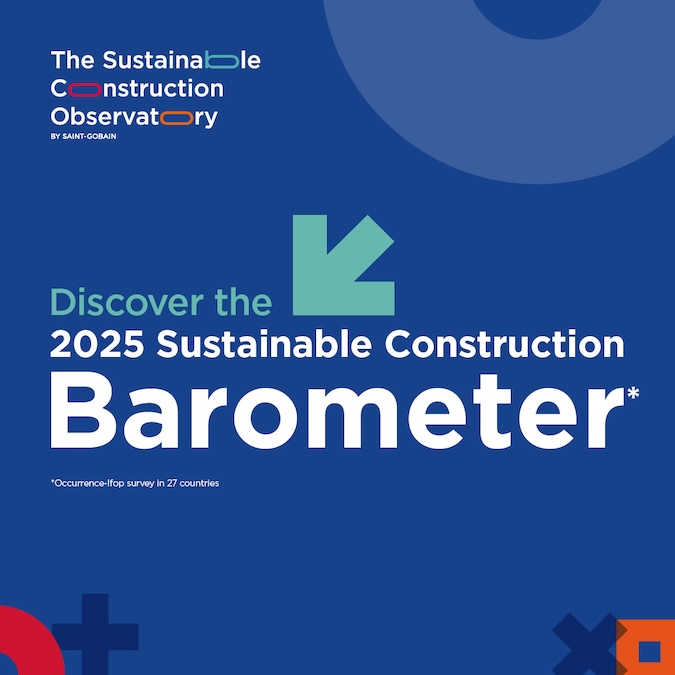Sustainable Construction: Canada and Global Trends Decrypted by the 3rd Edition of the Saint-Gobain Barometer
Published 05-07-25
Submitted by Saint-Gobain Corporation

Sustainable Construction Barometer 2025: While progress is being made, Canada is still lagging behind rest of world.
Saint-Gobain, global leader in light and sustainable construction, reveals the results of the third edition of its Sustainable Construction Barometer, a worldwide survey conducted in 27 countries amongst 4,000 stakeholders of the industry and 27,000 citizens to track progress of this priority topic.
While we might see ourselves in Canada as the avant-garde by being more environment-friendly and eco-conscious, this year’s Barometer paints a different story as it appears that we still have a blind spot when it comes to sustainable construction.
As Canada is facing both a housing crisis and experiences an increase in extreme weather events due to climate change, it appears more important than ever to tackle those challenges together and think about building more resilient and sustainable housing solutions.
You can also find more details of this year’s Sustainable Construction Barometer in the official press release below.
At the crossroads of demographic, social, energy, and climate challenges faced by societies, the construction sector must accelerate its transformation towards a more sustainable model. This involves designing a built environment that positively contributes to the health and well-being of individuals, is resilient to climate hazards, has low carbon emissions, and provides accessible housing for all—without compromising on quality or performance.
This transition cannot happen without the collective commitment of all industry stakeholders. It is with this goal in mind that Saint-Gobain launched the Sustainable Construction Observatory in 2023. As part of this initiative, the 3rd edition of the Sustainable Construction Barometer, a global study conducted with Occurrence–IFOP, is presented today. It measures the progress made on this essential topic.
This study is structured around 24 questions, asked to 4,000 stakeholders representative of the sector, along with an additional 27,000 citizens who responded to four specific questions. The responses helped identify key levers to accelerate sustainable construction in Canada
Benoit Bazin, Chairman and CEO of Saint-Gobain: “The conclusion is simple: we must act now. For sustainable construction to become the norm, it must be better understood and fully integrated into the expectations of both citizens and professionals. Beyond its environmental impact, its tangible benefits in terms of comfort, health, and well-being are still too often unknown or underestimated. To scale up, a global approach adapted to local realities is essential, taking into account uses, territories, and on-the-ground realities.”
Jean-Claude Lasserre, CEO of Saint-Gobain in Canada: “Both the housing and environmental challenges Canada face today are key topics that need to be tackled together to build a better future for all Canadians. This year’s Barometer results clearly show that there is a need for the construction industry to foster collaboration amongst all key players to raise awareness around sustainable construction’s environmental, societal and monetary benefits. Building more resiliently and sustainably is not only an aspiration, it is a necessity.”
A global analysis to accelerate sustainable construction all around the world
Launched in 2023 on a scope of 10 countries, the Sustainable Construction Barometer now covers 27 countries1, with a broad spectrum of stakeholders: professionals, students, elected local officials / local government representatives and members of associations. New this year, the survey also surveyed 27,000 regular citizens, giving them a voice in the debate on sustainable construction.
Four key learnings
- Greater awareness, a shared sense of urgency, and strong public support.
- A general, shared desire to go further. Across the board, private actors are seen as the most legitimate driving force, though regional priorities differ.
- A notion still centered on the environment, but resilience is gaining ground, while residents' well-being remains secondary.
- Well-informed but insufficiently trained stakeholders, which hinders concrete commitments.
A greater awareness of sustainable construction
67% of stakeholders claim to have a good grasp of the concept of sustainable construction. This figure has risen by 6 points over the past year.
The perceived urgency to act on the subject remains high: 69% of stakeholders consider the implementation of more sustainable construction a priority. This stable result is backed up by a perception shared by citizens, who are on board with the issue: 60% consider it a priority, and 95% consider it important. The challenge now lies in converting this high level of stakeholder and public awareness into concrete actions, while taking local specificities into account.
In Canada, the proportion of stakeholders claiming to have a good understanding of sustainable construction rose by 20 points year over year to stand at 71%. But the country faces a challenge when it comes to its general citizen population where only 22% of Canadians say they have heard about sustainable construction and know exactly what it is. Also, Canadians are less likely (52%) than in the rest of the world to believe implementing more sustainable construction solutions is a priority.
Beyond the consensus to accelerate the sector's transition, the role of private players is praised
87% of stakeholders believe that we need to “go further” in sustainable construction. Those involved in the design phase, positioned upstream in the value chain, appear as essential drivers: 56% of stakeholders consider architects and engineering firms to be the most legitimate players to advance this transition, followed by private companies in the sector at 44%.
However, priorities vary widely from region to region:
- In Asia-Pacific, Africa and the Middle East, the adaptability of buildings appears to be a recurring concern;
- In Latin America, the use of eco-friendly materials is emerging as a key issue;
- Europe stands out for its strong interest in building renovation;
- In North America, the issue of affordability is more to the fore.
This diversity of regional challenges underlines the importance of tailoring sustainable construction strategies to local specificities, while preserving a strong global dynamic.
A definition still largely associated with the environment, but resilience is gaining ground, while well-being remains in the background
While stakeholders claim to better understand the concept, they still associate sustainable construction primarily with environmental issues. The energy efficiency of buildings (35%) and the use of ecofriendly materials (31%) remain the main criteria for defining the concept.
Resilience in the face of climatic hazards is becoming an increasingly important issue. This topic has seen the strongest growth since the previous edition, reaching 21% (+8 points compared to 2024). Its importance varies by region, topping concerns in Africa (35%) and Asia-Pacific (32%), regions particularly exposed.
The “human” dimension of sustainable construction is still struggling to gain acceptance and remains relegated to the background. Only 15% of stakeholders and 15% of citizens associate sustainable construction with improved occupant well-being, even though this aspect could play a key role in its acceptance and deployment.
Stakeholder awareness still insufficiently translated into concrete commitments
Although stakeholders claim to be familiar with sustainable construction, only 28% say they are fully informed on the subject, and 35% of professionals have taken dedicated training. This still partial mastery of the subject may explain a certain limit to concrete commitments.
- 78% of students consider training in sustainable construction to be differentiating for employment, but only 40% would refuse an offer from a non-committed company.
- 67% of professionals say they assess the carbon footprint of their projects, but only 30% do so systematically.
- 51% of elected representatives say they would like to exclude non-committed projects from public procurement contracts, but only 37% have taken this step, a result (+26 points compared to 2024) which is nevertheless an encouraging sign.
- 51% of associations plan to call for a boycott of companies deemed to be under-invested, but only 24% have taken action.
The challenge for all value chain actors is therefore to transform this collective awareness into concrete actions. This challenge is a tremendous opportunity for mobilization.
Focus on sustainable construction in Canada
- With Canada being part of the global survey for a second year, it appears that industry stakeholders remain engaged towards sustainable construction and see it as a priority.
- But there is a clear need for more awareness and education within the Canadian population as only 22% have heard and know what sustainable construction is.
- Top 3 actions that need to be put in place to accelerate the development of sustainable construction:
- Stakeholders
- Raise awareness among all stakeholders and strengthen their collaboration (40%)
- Train professionals more (30%)
- Make sustainable material, products and solutions more competitive (29%) – it was 39% in 2024, an improvement in understanding the cost of sustainable solutions
- Canadians (general population)
- Make sustainable material, products and solutions more competitive (38%)
- Prioritize the use of bio-materials over conventional materials (26%) & Raise public awareness of the challenges of sustainable construction (26%) & Make sustainable performance of constructions more visible and transparent (26%)
- Stakeholders
Beyond the Barometer, the Sustainable Construction Observatory
The Sustainable Construction Observatory, launched in 2023, is also structured around Sustainable Construction Talks - meetings held internationally, alongside major multilateral events, but also at national level - and an online media Constructing a Sustainable Future, which today publishes its third special edition in paper and flipbook formats on the theme: “Sustainable Construction: How to keep innovating?”. Through the eyes of experts and inspiring projects, this edition explores the levers needed to accelerate the sector's transformation towards more sustainable construction.
About Saint-Gobain
Worldwide leader in light and sustainable construction, Saint-Gobain designs, manufactures and distributes materials and services for the construction and industrial markets. Its integrated solutions for the renovation of public and private buildings, light construction and the decarbonization of construction and industry are developed through a continuous innovation process and provide sustainability and performance. The Group, celebrating its 360th anniversary in 2025, remains more committed than ever to its purpose “MAKING THE WORLD A BETTER HOME”.
€46.6 billion in sales in 2024
More than 161,000 employees, locations in 80 countries
Committed to achieving net zero carbon emissions by 2050
1Countries: Argentina, Brazil, Canada, China, Colombia, Czech Republic, Egypt, Finland, France, Germany, India, Indonesia, Italy, Mexico, Morocco, Norway, Poland, Portugal, Saudi Arabia, South Africa, Spain, Switzerland, Turkey, United Arab Emirates, United Kingdom, United States, Vietnam

Saint-Gobain Corporation
Saint-Gobain Corporation
About Saint-Gobain
Worldwide leader in light and sustainable construction, Saint-Gobain designs, manufactures and distributes materials and services for the construction and industrial markets. Its integrated solutions for the renovation of public and private buildings, light construction and the decarbonization of construction and industry are developed through a continuous innovation process and provide sustainability and performance. The Group’s commitment is guided by its purpose, “MAKING THE WORLD A BETTER HOME”.
€47.9 billion in sales in 2023
160,000 employees, locations in 76 countries
Committed to achieving net zero carbon emissions by 2050
For more information about Saint-Gobain, visit www.saint-gobain.com and follow us on X @saintgobain
More from Saint-Gobain Corporation

